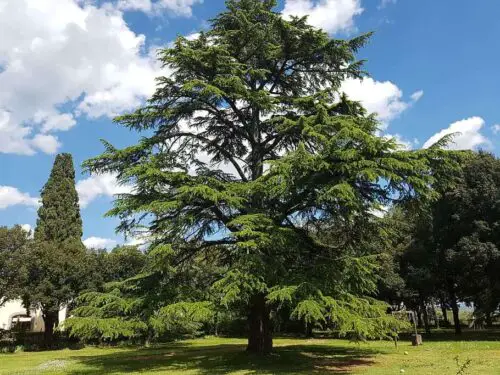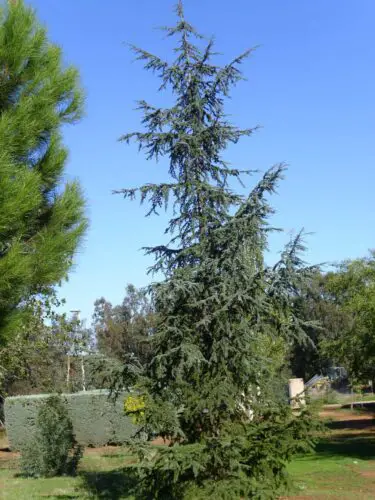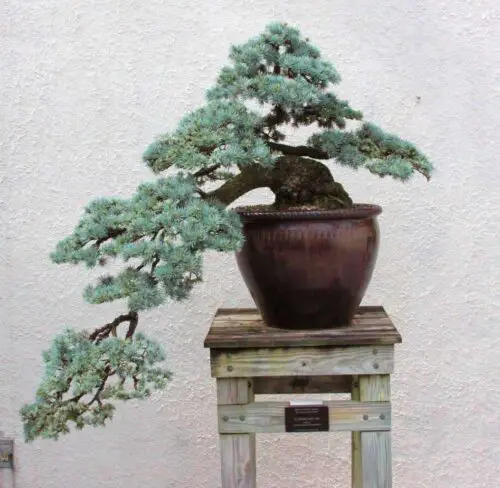Blue Atlas Cedar is one of the most popular trees among other Atlas cedars. Cedrus Atlantica has silver blue foliage which is very incredible cedars and it expands many branches that makes this blue atlas tree fully evergreen. This tree is very graceful and it can be positioned to any landscape. Let me Tell you about something that trees are the ones which give a better look to a garden , a lawn or a school.
The reason why people choose blue atlas cedar over other popular trees is that these are easy to maintain and give a pyramidal shape which looks amazing. This tree does maintain its narrow cone shape in early years of its life and when its age around 18-20 years it starts widening its shape to pyramidal. These trees look eye catching in a large area, but if you have a big backyard, you can grow it too.
Now let me tell you about its background information.
Background Information
The Binomial or Scientific name of Blue Atlas Cedar is Cedrus Atlantica ‘Glauca’ and it is from the Pinaceae Family which is a species of Pine Family. This Tree was first discovered on the Middle Atlas & High Atlas of Morocco and one source add one more origin which is Algeria.
Some Sources claim it as a subspecies of Lebanon cedar and Some refer to it as a distinct species. According to University of Utah and North Carolina Extension gardener the height of blue altas cedar is up to 30-40 feet and it widens 30-40 feet. The USDA hardiness zone of this plant is 6-9.
You can buy this this live plant from the below links.

3 Varieties of Cedar Tree (Very Different and Beautiful):
Horstmann Blue Atlas Cedar – CHECK PRICE IN ETSY
Weeping Blue Atlas Cedar (Serpentine) – CHECK PRICE IN ETSY
Golden Deodar Cedar Tree – CHECK PRICE IN ETSY
Quick Facts:
| Scientific Name | Cedrus atlantica |
| Other Names | Weeping blue Atlas cedar |
| Origin | Africa |
| USDA Hardiness Zone | 6–9 |
| Plant Type | Evergreen tree |
| Soil Needs | Well-drained |
| Height | 50–60 feet tall |
| Width | 35–40 feet wide |
| Flower Color | No Color |
| Light Requirement | Full sun |
| Bloom Time | Doesn’t Flower |
| Uses | Landscapes and garden |
| Pruning | Slightly Trim Once In Few Year |
| Pests Infestation | Scale |
| Fertilizer | Liquid based plant food |
How to Grow Blue Atlas Cedar
This tree (Cedrus Atlantica) can grow in many types of soils but the best one would be a mixture of clay, silt and sand in a ratio of 20-40-40. These trees love direct sunlight So make sure to choose a good location where it gets proper 8-10 hours sunlight but also it adjusts in shade area’s that’s the beauty of this cedar Tree.
Grow Blue Atlas Cedar : When these trees are young you should protect it from heavy winds and storms, those times provide them shelter. These types of Trees (Cedrus Atlantica) are slow growers so you need to stay calm & stop questions on how much time it will take to reach a certain height, as it takes about 15 years to reach 30 feet tall means it will grow only 1 and 1/2 feet every year. You have to take care of it, this is the time when the tree is making its trunk (main stem of a tree ) strong.
Here are the 8 tips on growing Cedrus Atlantica :
Light
It requires full light so no need to grow it in a shade area.
They need 6-8 hours of sunlight so that it can make its stems and grow bigger & healthy.
Soil
They can tolerate ground soil but you can give them extra minerals for its proper growth.
It includes sand , clay and silt in a proportion of 40:20:40 % and this tree will be good to go as water draining can be smooth now with this.
Potting Repotting
In this plant it is not required as it will be growing in grounds but you can remove the extra grass growing adjacent to the roots of this tree.
Temperature
It is possible that your Cedrus Atlantica can get affected with the temperature below freezing.
Taking good care of blue atlas cedar means watering , feeding plant food(fertilizer) etc. But if freezing can be below the point for a longer period of time and lose its leaves eventually die. So take good care, Most of the time this tree survives.
Fertilizer
For blue atlas cedar, you can use fertilizer in early spring every year, the best one which is used by many is 10-8-6 fertilizer which contains 10 % nitrogen 8 % phosphorus 6% potassium , this amount is sufficient for cedar tree. Fertilizer is used to boost its growth and plants overall strength.

Fertilizer
Humidity
These plants (Cedrus Atlantica) can tolerate moderate levels of humidity when they are young. After maturing it can adjust to moisture easily.
Pruning
Pruning which actually removes the dead stem and leaves So that it should not grow ugly. You can prune in early spring and cut those weak branches or leaves which are fading. Also pruning is done because it needs to be in its shape and not to look bushy and ugly.
Propagate
The best way to grow it using the seeds, no other way like stem cutting. You will get the seed from the tree itself. The procedure is complicated so I have explained everything in the article below on how to propagate it.

Blue Atlas Cedar Care
To care for this tree you need good compost so the tree gets good drainage. Put this in 1-2 inches near the roots of the soil surface. Here are the Tips to better care Cedrus Atlantica:
Water them only.
when you see the soil surface is fully dry. When the plant is young it needs moisture.
To retain moisture.
you need to put mulch on the top layer of the plant (Cedrus Atlantica) so it doesn’t get dry easily.
Use of bark or bulk straws.
Just put that only about 2 inches don’t touch or anything. The soil and water will adjust the mulch over the surface.
Prune it.
to make it in proper shape. For the pests and diseases spray Neem oil to get rid of them.
Pests and Diseases Problems
According to the Tree Heritage, This Tree gets affected by fungal disease which is know by the name Sirococcus Blight. To Notice these diseases you have to check if your Cedrus Atlantica needles are changing their color to pink and after pink it turns to brown and then it starts to fall. Unfortunately this disease has no cure so report your tree disease to the forest department office so they can find a cure. Other than this this tree is free from other diseases & pests.
Blue Atlas Cedar Propagation
Let me tell you that the leaves of the tree are like needles and it is called as coniferous tree. these needles can be use to take out seeds from existing trees. You can buy it from offline stores or from online sale here is the link.
If you have existing tree follow Steps:
Take out Seeds
from its cones(needle like leaves), you should take a healthy cone and then you will need a moisture for its germination so take a tissue paper and put the seed in it and spray water on the seed and cover it with another tissue paper, then keep it in the refrigerator.
Spray after every 2-3 days.
if the water gets dry. After that, as soon as germination starts, put the seed in a pot of good organic compost and well drained soil.
Only 1 seed for a 4-5 inch pot.
Then cover the pot with a plastic bag and make 2-3 holes in the plastic bag.
Once you see its sprout.
after 2-3 weeks, then place it in full sunlight.
At the time of germination.
keep it in direct sunlight. So that how you do propagation, After taking care of it, it will grow and maintain itself.
Types of Blue Atlas Cedar
There are many types(variety) of atlas cedar trees. We have described some of the variety with additional information on each of the cedar trees. Here is list on types of blue atlas cedar :
Weeping Blue Atlas Cedar
Weeping blue atlas cedar trees grow to their highest potential in hot and warmer seasons. weeping cedar has branches flowing down looks like waterfalls and icy blue leaves give a stunning appearance. Cedar tree is very special & unique, very similar to blue atlas cedar and can be added to any landscape. This tree can grow with less care and it gives your garden a beautiful evergreen look.
It can grow upright and has needle-like leaves of silver blue color. Shake can be used to support this plant trunk in heavy storms. It can attract everyone’s attention because of its striking and usual structure. This can grow in USDA hardiness zone 6 to 9.
The scientific name of this tree is cedrus atlantica ‘glauca pendula’ and it is special because of the branches moving downwards making it a great specimen as this is the only tree which could be uniquely structured. It is one of the trees which can be used to make a source or destination point in your garden or a landscape so that people don’t get lost.
It has a parent tree which is atlas cedar which has pyramidal shape, amazing giant size and a lot of foliage in blue. They are hardy to zone 6 to 9 and can tolerate the cold climate. It is noticed that weeping blue cedar can withstand -10 degree OF temperature which is extraordinary to rare trees. It also has a robust trunk so nothing to worry about the cedar tree before installing it in your large garden.
Blue Atlas Cedar Serpentine
Blue atlas cedar serpentine is actually unique because of its structure which looks like a snake moving in a zigzag pattern creating “S ” using its branches. Its evergreen leaves give it a graceful look , it is grown in walls or in free standing with stake support when this tree is young. It can reach more than 14 feet high and can be spread longer if you have space. It’s a great specimen of weeping blue atlas cedar.
Horstmann Blue Atlas Cedar
Its branches are compact and it also has icy blue needles(leaves). Horstmann Blue Atlas Cedar is a semi dwarf tree which means its height is shorter than the dwarf trees. It has an uneven structure but it still looks quite good with bluish leaves. You can grow this tree in medium to small areas. Its bluish color quite blends in Cold Snowy weather.
Dwarf Blue Atlas Cedar
Dwarf blue atlas cedar is one such variety which looks evergreen & bright with its bluish leaves in winters and also it is quite stand out among other trees. This is dwarf variety it means it can grow much taller than its other variety about 450-50 feets high and 23-25 feet wider. The USDA Hardiness zones are 6 to 9 and can be grown in smaller areas. Plant this in where it can receive full sunlight so that it grows much bigger and healthier.
Columnar Blue Atlas Cedar
Columnar blue atlas cedar is a variety which grows upright and has bushy Blue green color leaves and shows silver foliage when mature. It is similar to blue atlas cedar having the same narrow pyramidal structure but having space in between diagonal shapes that is why it can be grown in short space gardens and lawns.
Buy Now Here is the Links:
Blue Atlas Cedar – Shop Now
3 Varieties of Cedar Tree (Very Different and Beautiful):
Horstmann Blue Atlas Cedar – CHECK PRICE IN ETSY
Weeping Blue Atlas Cedar (Serpentine) – CHECK PRICE IN ETSY
Golden Deodar Cedar Tree – CHECK PRICE IN ETSY
Blue atlas cedar wiki
Blue atlas cedar Wiki says these amazing trees are also planted in south lawn and white house where president of United states stays.
Blue Atlas Cedar bonsai
If you are interested in atlas cedar you probably see the pictures somewhere on Pinterest or Instagram about how beautiful atlas cedar bonsai look. It means they look just like a big cedar will look, it’s a mini version but it is worth checking. If you want to purchase its artificial miniature blue cedar tree here is the link to buy.
Now check out the images of blue atlas cedar bonsai :


Buy Artificial Bonsai of Cedar Tree
Shop Now
How to train a weeping blue atlas cedar
In order to obtain the desired cascading or weeping form, the branches of a blue atlas weeping cedar (Cedrus atlantica ‘Glauca Pendula’) are often shaped and guided during training. This is a step-by-step instruction on how to train a weeping blue atlas cedar:
- A young weeping blue atlas cedar with a supple and flexible structure is the best option. Compared to older, more established trees, younger trees are simpler to train.
- Choose an appropriate planting location: Weeping blue atlas cedars like full sun to moderate shade and well-draining soil. Pick a spot where there is enough room for the tree to expand and cascade without being obstructed.
- Create a reliable support system: Place a reliable trellis or other support system close to the tree. This will help the branches acquire their habit of weeping by acting as a guide and a support.
- Start your training during the dormant season, which is usually in late winter or early spring, to prune for structure. To build a sturdy foundation, start by removing any broken or crossed branches.
- Determine the major branches: Choose the major branches that will make up the basic framework of the weeping shape. From the stem, these branches should branch out at regular intervals.
- Branches may be attached to the support structure by gently bending them in that direction and securing them with twine or soft ties. Give the branches room to hang freely over the support.
- Maintain desired shape: As the tree matures, keep guiding and anchoring the branches to the framework to ensure that they have the intended weeping shape. Make sure the ties are not excessively tight on a regular basis to avoid damaging the branches.
- Maintenance pruning: Remove any potential robust upright branches by doing routine maintenance pruning. These sprouts need to be removed right away since they might obstruct the weeping form.
- Monitor growth and make required adjustments: Keep an eye on the weeping blue atlas cedar’s development and alter the training as needed. To keep the ideal shape, keep guiding and securing the branches.
- Keep calm: It takes time and attention to train a weeping blue atlas cedar. The tree may need a few years to fully establish its weeping behavior. Over time, consistent upkeep and care will assist in achieving the ideal form.
FAQ’s
How big does a blue atlas cedar get? According to University of Florida , blue atlas cedar height of 40 to 60 feet tall , so its quite big and it spreads 25 to 40 feet long when matured.
How much does a blue atlas cedar cost? This blue atlas cedar can cost you around $160 with 4-5 feet height and 2-2.5 years old plant. If you want to take fresh young plants it will cost you around $30. It all depends on size , different websites have different prices and offline stores. You can take seeds that will also be cheaper but it really takes time for a seed to become a plant so try to buy a plant which is 2 year old.
How long do blue atlas cedars live? The blue atlas cedars can live more than 80 years reaching to a 50 feet tall height and wide at 40 feet long. It sure grows very slow but you can be enjoy watching it as this tree can live same as humans average life so its beautiful to see when you are old this tree is also gets old. Its basically your friend of younger age.
How do you care for blue atlas cedar? When blue atlas cedar tree is at its younger age it needs plenty of water to make cedar roots stronger but remember not to over water it as this can spoil its roots always check the soil is dried if it is dry water it else not. On hot days you should check its soil daily as it requires water in those days. Mulching can be used so that it can retain water for a longer time. These blue atlas cedars has big size that is why they are grown in large fields and in sequence. Blue cedars require deep watering because when the tree grows in a garden or a landscape its root spreads about a few feet’s this is why you need to provide it with a lot of water. Sometimes in the rainy season your trees can get it from nature, this makes us relax for the season. They are one of the cedar trees which reaches to a height of over 60 feet tall and spreads wide over 40 feet.
Can you trim a blue atlas cedar? You can do it but not often else you are limiting its growth. Blue atlas cedar grows very well so it needs pruning early spring if you see any dead needles and branches else it’s not needed. In the United States there are 3 types of cedar trees which are Deodar , Lebanon and Atlas cedar all these 3 don’t need pruning.
How do you train blue atlas cedar? To Train blue atlas cedars you need to put a stake diagonally on the ground so that the stake doesn’t hurt the tree’s root ball and then stick the stake on the trunk using aluminum wire or belts , When it begins to grow and belt becomes tight , then lose the belt to free some space. Stake is used to protect trees from heavy wind storms.
Conclusion
It’s a tree , it will take a lot of years to make it to a certain size and once it becomes mature the pyramidal shape is amazing, this one is actually easy to grow and care for , it is pests and diseases free, rare to get disease. If you have a big garden, go for it. As it will be providing most of the evergreen look to your garden.
Black Eyed Susan Vine – 7 Tips to Grow, Care, propagate, Prune [Guide]
Pygmy date palm – How to Grow (Phoenix roebelenii) – Caring Guide
China Doll Plant – How to Care, Benefits, Propagation, Pests
Purple Passion Plant – Care, Grow , Propagate, Benefits, Seeds Sale
